Run channel structure
a technology of channel structure and run channel, which is applied in the direction of wing accessories, transportation and packaging, wing arrangements, etc., can solve the problems of door glass stopping and unpleasant strike sound, and achieve the effect of reducing the ascent speed of door glass, reducing the glass strike, and reducing the reaction for
- Summary
- Abstract
- Description
- Claims
- Application Information
AI Technical Summary
Benefits of technology
Problems solved by technology
Method used
Image
Examples
Embodiment Construction
[0022]A vehicle 10 shown in FIG. 1 includes a vehicle body 11 equipped with left and right front sash doors 12, 13 and left and right rear sash door 14, 15. The vehicle body 11 has a roof 16 disposed over the left and right front sash doors 12, 13 and the left and right rear sash doors 14, 15.
[0023]The right front sash door 13 includes a door body 17, a sash body 18 provided on an upper part of the door body 17, and a run channel structure 20 (see FIG. 2) provided in the sash body 18. The right front sash door 13 also includes a door glass 21.
[0024]It is to be noted that the left and right front sash doors 12, 13 have the same structure and are symmetrically disposed while the left and right rear sash doors 14, 15 have the same structure and are symmetrically disposed.
[0025]FIG. 2 shows the right front sash door 13 in a closed position.
[0026]The sash body 18 of the right front sash door 13 is equipped with a weatherstrip 22 and the run channel structure 20. The vehicle body 11 has a...
PUM
 Login to View More
Login to View More Abstract
Description
Claims
Application Information
 Login to View More
Login to View More - R&D
- Intellectual Property
- Life Sciences
- Materials
- Tech Scout
- Unparalleled Data Quality
- Higher Quality Content
- 60% Fewer Hallucinations
Browse by: Latest US Patents, China's latest patents, Technical Efficacy Thesaurus, Application Domain, Technology Topic, Popular Technical Reports.
© 2025 PatSnap. All rights reserved.Legal|Privacy policy|Modern Slavery Act Transparency Statement|Sitemap|About US| Contact US: help@patsnap.com



